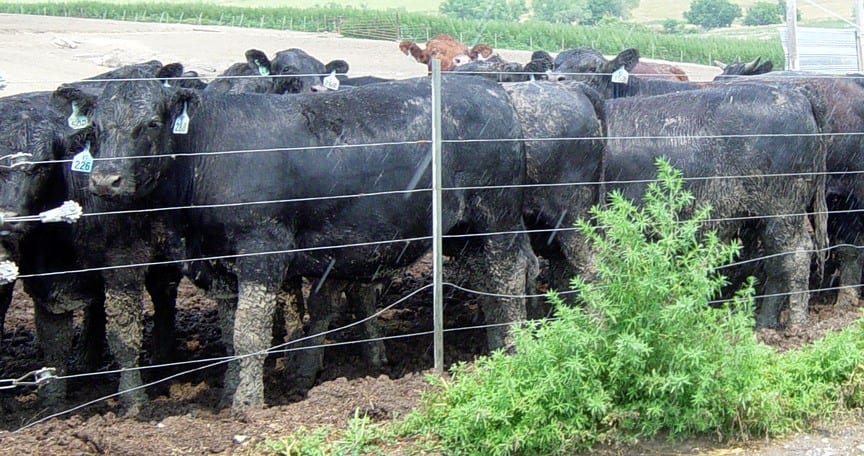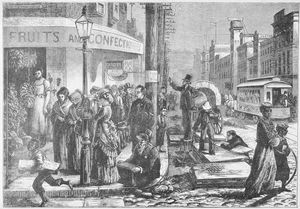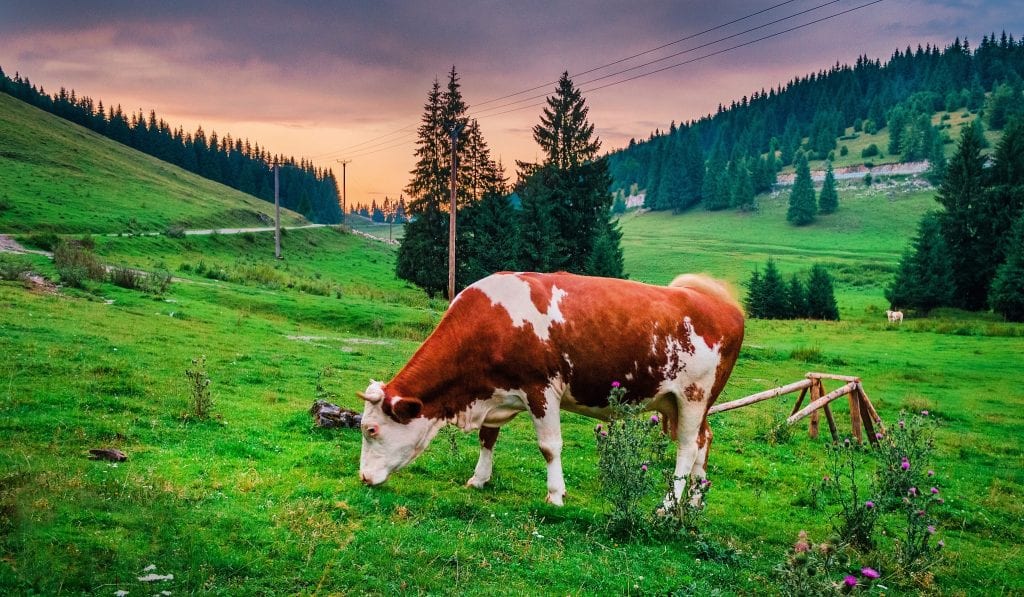
Feedlots have a bad reputation in the holistic nutrition community, and rightly so. Beef cattle fed on feedlots are given a corn-based diet designed to quickly fatten them up. While on the surface that sounds great, as it turns out it is far from great in the end.
First, grain is not what cattle are meant to eat. Without veterinary intervention, cattle would only be able to tolerate the diet and living conditions for a couple of weeks.1 Second, the combination of a high grain diet and large numbers of cattle in a small space sets up an environment primed for disease and death.
Why were Feedlots Created?
How on earth did we get to where we are today with the feedlot system?

According to Hubbs, during the industrialization of the U.S. as people moved to the cities and more and more immigrants arrived, food supplies were stressed. Fresh meat was rarely available in the cities.
In a push to feed the masses, grains which grow easily and store nicely, were the focus. Improved technologies allowed for greater yields and eventually led to surpluses in corn.
The surplus corn was fed to cattle for a couple of weeks to offset the weight loss observed when moving them by train to urban areas for butchering. So far, so good.
Next, U.S. ingenuity led us down the path of cheaper (and arguably better) ways of getting meat to urban dwellers.
The evolution of that process led producers to realize they could fatten cattle for months in feedlots, butcher at top weight, and ship the carcasses in refrigerated train cars versus shipping the live cattle. This allowed producers to maximize profits while providing a nutrient dense food at an affordable price.
It seemed to be a win/win for producers and consumers.
But let’s take a closer look at feedlots, and whether or not this really works out for the consumer in the long run.
It is interesting to note that the laws in Colorado governing feed lots were initially designed to protect the owner of the cattle from theft. Great care is taken to track each animal traveling to the feedlot and then to the processing plant (C.R.S. § 35-53.5-109).
Laws have also been established to ensure livestock herd health through the Livestock Health Act (C.R.S. § 35-50). Article 50 of Title 35 of the Colorado Revised Statutes spells out with great detail the procedure one must follow if a head of beef is suspected to be sick. The laws are well designed to stop the spread of disease quickly.
To stop the spread of disease quickly. Got that? Not to ensure the optimum health for the animal, which will then be consumed by people.
Win Win? ‘Fraid Not
Yes, there has been success is providing meat at an affordable cost to the consumer. And yes, various steps have been put in place to protect the cattle from disease. However, the win/win has been short-lived for all parties.

Beef cattle don’t thrive on grain. While the negative effects may start with digestive issues, it doesn’t end there. The high grain diet has a negative impact on the entire nutrient profile of beef.
Think about this—the cattle’s nutrient profile is negatively impacted. We consume that beef. That means that our health is impacted as we are eating less nutritionally complete food. Remember, food is medicine, but only if it is healthy and nutritionally complete!
Key Nutrients Missing
According to Daley et. Al 2, cattle finished on grass versus grain have a better fatty acid profile. This beef has higher “precursors of vitamins A and E, as well as cancer fighting antioxidants such as glutathione, and superoxide dismutase activity.” Consumers eating grain fed beef are robbed of these key cancer fighting nutrients.
We have an epidemic of chronic disease in this country costing $3.3 trillion dollars. According to the CDC, these diseases are diet and lifestyle driven.
Cancer is the second leading cause of death in this country and a heartbreaking experience for affected families.
Food is Medicine: Even the Right Beef Can Help Prevent Cancer

The question many in the food and nutrition industry ask is this: Would consumers choose a beef product that can contribute to the prevention of cancer?
There is an increased availability of grass finished beef. That is the beef that is shown to provide people (consumers) with the key nutrients needed to prevent cancer!
That means that consumers must be educated about the benefits of grass finished beef so they can make an informed decision.
Choosing for Short Term or Long Term
Choose low cost beef and lose out on the nutrients that can help prevent disease.
Or choose the higher cost grass finished beef and get the nutrients you need to stay healthy.
There is a price to pay either way with the gamble belonging to the consumer.
My choice? I’m choosing the grass finished beef.
I’d rather prevent disease rather than fight it.
References
1Hubbs, P., M.A. (2010, October 8). “The Origins and Consequences of the American Feedlot
System”. Retrieved September 16, 2019, from http://hdl.handle.net/2104/8032
2 Daley, C. A., Abbott, A., Doyle, P. S., Nader, G. A., & Larson, S. (2010). A review of fatty acid profiles and
antioxidant content in grass-fed and grain-fed beef. Nutrition journal, 9, 10.
doi:10.1186/1475-2891-9-10
About Chronic Diseases. (2019, July 30). Retrieved September 22, 2019, from
https://www.cdc.gov/chronicdisease/about/index.htm#risks.
C.R.S. 35-50 (Lexis Advance through all laws passed during the 2019 Legislative Session)
C.R.S. § 35-53.5-109 (Lexis Advance through all laws passed during the 2019 Legislative Session)
Grandin, T. (2016). Evaluation of the Welfare of Cattle Housed in Outdoor Feedlot Pens.
Veterinary and Animal Science, 23-28. http://dx.doi.org/10.1016/j.vas.2016.11.001
Photo credits
Feedlot photo by bluekdesign on Morguefile
Cattle on grass photo by Haseeb Jamil on Unsplash
“Street scene in Philadelphia.” New York Public Library Digital Collections.
Photo by Matheus Ferrero on Unsplash
